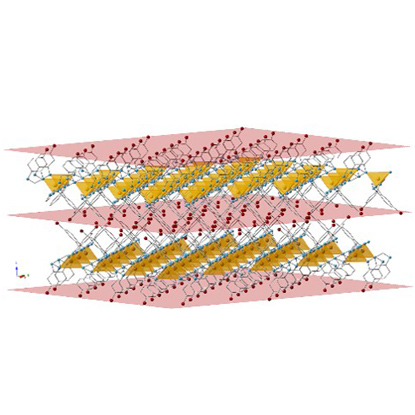New porous materials
In this research line we undertake the synthesis of different types of crystalline porous materials, including extended porous metal-organic frameworks (MOFs), and more advanced solution-processable porous materials such as hydrogen-bonded organic frameworks (HOFs) and metal-organic polyhedra (MOPs).
We cover from their synthesis with control over the crystalline size to their advanced physico-chemical characterization and further implementation.
We investigate the potential of these novel porous materials for gas separations and carbon dioxide capture, as well as for sensing and for light-harvesting and photocatalysis.
We cover from their synthesis with control over the crystalline size to their advanced physico-chemical characterization and further implementation.
We investigate the potential of these novel porous materials for gas separations and carbon dioxide capture, as well as for sensing and for light-harvesting and photocatalysis.
Recent relevant publications
Semiconductor Porous Hydrogen-Bonded Organic Frameworks Based on Tetrathiafulvalene Derivatives”
J. Am. Chem. Soc. 2022, 144, 9074−9082
“Multivariate sodalite Zeolitic Imidazolate frameworks: a direct solvent-free synthesis”
Chem. Sci., 2022, 13, 842–847
“Solvent-free synthesis of ZIFs: a route toward the elusive Fe (II) analogue of ZIF-8”
J. Am. Chem. Soc. 2019, 141, 7173–7180
“A highly stable and hierarchical tetrathiafulvalene-based metal–organic framework with improved performance as a solid catalyst”
Chem. Sci. 2018, 9, 2413–2418
J. Am. Chem. Soc. 2022, 144, 9074−9082
“Multivariate sodalite Zeolitic Imidazolate frameworks: a direct solvent-free synthesis”
Chem. Sci., 2022, 13, 842–847
“Solvent-free synthesis of ZIFs: a route toward the elusive Fe (II) analogue of ZIF-8”
J. Am. Chem. Soc. 2019, 141, 7173–7180
“A highly stable and hierarchical tetrathiafulvalene-based metal–organic framework with improved performance as a solid catalyst”
Chem. Sci. 2018, 9, 2413–2418
Bidimensional materials
From a coordination chemistry approach, we prepare 2D materials as an alternative to the classical inorganic compounds as graphene, MoS2 or MX3 (transition metal trihalides), taking advantage of the chemical design to introduce elusive properties in stable materials.
Recent relevant publications
“Chemical design and magnetic ordering in thin layers of 2D MOFs”
J. Am. Chem. Soc. 2021, 143, 18502–18510
“Fast Polymeric Functionalization Approach for the Covalent Coating of MoS2 Layers”
ACS Appl. Mater. Interfaces 2021, 13, 36475–36481
“2D magnetic MOFs with micron-lateral size by liquid exfoliation”
Chem. Commun. 2020, 56, 7657–7660
“Isoreticular two-dimensional magnetic coordination polymers prepared through pre-synthetic ligand functionalization”
Nature Chem. 2018, 10, 1001–1007
J. Am. Chem. Soc. 2021, 143, 18502–18510
“Fast Polymeric Functionalization Approach for the Covalent Coating of MoS2 Layers”
ACS Appl. Mater. Interfaces 2021, 13, 36475–36481
“2D magnetic MOFs with micron-lateral size by liquid exfoliation”
Chem. Commun. 2020, 56, 7657–7660
“Isoreticular two-dimensional magnetic coordination polymers prepared through pre-synthetic ligand functionalization”
Nature Chem. 2018, 10, 1001–1007
Biohybrid Materials
We prepare biocomposites and nanoparticles based on biocompatible MOFs to be used as scaffolds for the encapsulation and controlled release of bioactive (macro)molecules, obtaining advanced delivery systems for improved therapies.
Recent relevant publications
“Exploiting the Redox Activity of MIL-100 (Fe) Carrier Enables Prolonged Carvacrol Antimicrobial Activity”
ACS Appl. Mater. Interfaces 2022, 14, 10758–10768
ACS Appl. Mater. Interfaces 2022, 14, 10758–10768

















